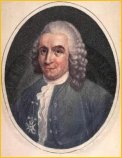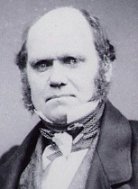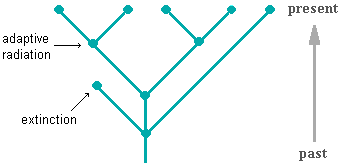How Has The Theory Of Evolution Changed How Biologists Classify Organisms
In this tutorial you will exist learning about the Linnaean ![]() organisation of nomenclature used in the biological sciences to describe and categorize all living things. The focus is on finding out how humans fit within this organisation. In addition, you will discover part of the great diversity of life forms and come to understand why some animals are considered to be close to us in their evolutionary history.
organisation of nomenclature used in the biological sciences to describe and categorize all living things. The focus is on finding out how humans fit within this organisation. In addition, you will discover part of the great diversity of life forms and come to understand why some animals are considered to be close to us in their evolutionary history.
How many species are there?
This is not an easy question to answer. Nearly ane.eight 1000000 have been given scientific names. Thousands more are added to the list every year. Over the terminal half century, scientific eastwardstimates of the full number of living species have ranged from iii to 100 one thousand thousand. The most recent methodical survey indicates that it is likely to exist close to 9 one thousand thousand, with 6.5 million of them living on the state and 2.2 million in the oceans. Tropical forests and deep ocean areas very likely hold the highest number of all the same unknown species. However, we may never know how many there are because it is probable that nigh will become extinct before being discovered and described.
The tremendous diversity in life today is not new to our planet. The noted paleontologist Stephen Jay Gould estimated that 99% of all plant and animal species that take existed have already get extinct with nearly leaving no fossils. Information technology is also humbling to realize that humans and other large animals are freakishly rare life forms, given that 99% of all known animal species are smaller than bumble bees.
Why should nosotros be interested in
learning nearly the variety of life?
In social club to fully understand our own biological evolution, we need to exist aware that humans are animals and that we have close relatives in the fauna kingdom. Grasping the comparative evolutionary distances betwixt different species is important to this agreement. In improver, it is interesting to learn about other kinds of creatures.
When did scientists begin classifying living things?
Before the advent of modern, genetically based evolutionary studies, European and American biology consisted primarily of taxonomy ![]() , or classification of organisms into different categories based on their concrete characteristics and presumed natural human relationship. The leading naturalists of the 18th and 19th centuries spent their lives identifying and naming newly discovered plants and animals. Withal, few of them asked what accounted for the patterns of similarities and differences betwixt the organisms. This basically nonspeculative approach is not surprising since most naturalists 2 centuries ago held the view that plants and animals (including humans) had been created in their present course and that they have remained unchanged. As a consequence, it fabricated no sense to enquire how organisms take evolved through time. Similarly, it was inconceivable that two animals or plants may have had a common ancestor or that extinct species may take been ancestors of modern ones.
, or classification of organisms into different categories based on their concrete characteristics and presumed natural human relationship. The leading naturalists of the 18th and 19th centuries spent their lives identifying and naming newly discovered plants and animals. Withal, few of them asked what accounted for the patterns of similarities and differences betwixt the organisms. This basically nonspeculative approach is not surprising since most naturalists 2 centuries ago held the view that plants and animals (including humans) had been created in their present course and that they have remained unchanged. As a consequence, it fabricated no sense to enquire how organisms take evolved through time. Similarly, it was inconceivable that two animals or plants may have had a common ancestor or that extinct species may take been ancestors of modern ones.
 | |
| Carolus Linnaeus 1707-1778 |
I of the most important 18th century naturalists was a Swedish botanist and medical medico named Karl von Linn�. He wrote 180 books mainly describing found species in extreme detail. Since his published writings were mostly in Latin, he is known to the scientific world today as Carolus Linnaeus ![]() , which is the Latinized grade he chose for his proper name.
, which is the Latinized grade he chose for his proper name.
In 1735, Linnaeus published an influential book entitled Systema Naturae in which he outlined his scheme for classifying all known and yet to exist discovered organisms according to the greater or lesser extent of their similarities. This Linnaean organization of classification was widely accustomed by the early 19th century and is still the basic framework for all taxonomy in the biological sciences today.
The Linnaean system uses 2 Latin proper name categories, genus ![]() and species
and species ![]() , to designate each type of organism. A genus is a higher level category that includes ane or more species nether it. Such a dual level designation is referred to as a binomial classification
, to designate each type of organism. A genus is a higher level category that includes ane or more species nether it. Such a dual level designation is referred to as a binomial classification ![]() or binomen
or binomen ![]() (literally "2 names" in Latin). For example, Linnaeus described mod humans in his system with the binomen Homo sapiens
(literally "2 names" in Latin). For example, Linnaeus described mod humans in his system with the binomen Homo sapiens ![]() , or "man who is wise". Human is our genus and sapiens is our species.
, or "man who is wise". Human is our genus and sapiens is our species.
| genus | genus | ||
|---|---|---|---|
| species | species | species | species |
Linnaeus besides created higher, more inclusive classification categories. For instance, he placed all monkeys and apes along with humans into the order Primates ![]() . His apply of the word Primates (from the Latin primus significant "first") reflects the homo centered world view of Western science during the 18th century. It implied that humans were "created" start. Nevertheless, it likewise indicated that people are animals.
. His apply of the word Primates (from the Latin primus significant "first") reflects the homo centered world view of Western science during the 18th century. It implied that humans were "created" start. Nevertheless, it likewise indicated that people are animals.
| order | |||||||
|---|---|---|---|---|---|---|---|
| family | family | ||||||
| genus | genus | genus | genus | ||||
| species | species | species | species | species | species | species | species |
 | |
| Charles Darwin |
While the class of the Linnaean nomenclature system remains essentially the same, the reasoning behind it has undergone considerable modify. For Linnaeus and his contemporaries, taxonomy served to rationally demonstrate the unchanging order inherent in Biblical creation and was an end in itself. From this perspective, spending a life defended to precisely describing and naming organisms was a religious act because it was revealing the great complexity of life created by God.
This static view of nature was overturned in scientific discipline by the center of the 19th century past a pocket-sized number of radical naturalists, most notably Charles Darwin . He provided conclusive testify that development of life forms has occurred. In addition, he proposed natural option as the machinery responsible for these changes.
Late in his life, Linnaeus also began to have some doubts well-nigh species being unchanging. Crossbreeding resulting in new varieties of plants suggested to him that life forms could change somewhat. Still, he stopped curt of accepting the evolution of ane species into some other.
Why do we classify living things today?
Since Darwin'south time, biological classification has come to be understood as reflecting evolutionary distances and relationships between organisms. The creatures of our fourth dimension have had common ancestors in the by. In a very existent sense, they are members of the same family tree.
The groovy diversity of life is largely a result of branching evolution or adaptive radiations . This is the diversification of a species into dissimilar lines every bit they accommodate to new ecological niches and ultimately evolve into distinct species. Natural selection is the principal machinery driving adaptive radiation.

Copyright � 1998-201two by Dennis O'Neil. All rights reserved.
illustration credits
How Has The Theory Of Evolution Changed How Biologists Classify Organisms,
Source: https://www2.palomar.edu/anthro/animal/animal_1.htm
Posted by: hectorrusequithe.blogspot.com


0 Response to "How Has The Theory Of Evolution Changed How Biologists Classify Organisms"
Post a Comment